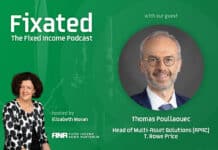
The start of 2024 has caught many investors off guard. Resilient US growth and inflation have defied expectations, leading to higher bond yields and a surging US dollar. Equities have paused following their strong advance since October 2023.
According to Stephen Dover, Head of the Franklin Templeton Institute: “A lot has happened in the last few months, underscored by significant moves in stocks, bonds, currencies and commodities. Those factors must now be considered when deploying or redeploying capital.”
The most significant market shift since the beginning of the year has been a dramatic and unanticipated rise in global bond yields. From their early January levels of 3.86%, US 10-year Treasury yields have climbed some 80 basis points to their current rate near 4.70%.
Rising Treasury yields have caused equity markets to wobble, with the S&P 500 Index down 3% from its late-March peak.1 Rising US yields have also propelled the US dollar higher in the world’s foreign exchange markets. Year-todate, the dollar is up 12% versus the Japanese yen and 4% in trade-weighted terms.2 Meanwhile, crude oil prices have advanced 16% in the first four months of the year.3
Dover says, “Several factors have accounted for these dramatic market shifts. But what we see as most important is the combination of resilient US growth (defying expectations of a recession) and sticky US inflation (which was supposed to keep falling but has not). As a result, the Federal Reserve (Fed) has indicated that any rate cuts will come later and more gradually than had been anticipated earlier this year. The re-pricing of Fed easing has been the most important driver of rising yields, which in turn has supported the US dollar and eroded demand for equities.
Also read: Defeating Inflation Will Take The Fed Longer Than It Expected
“Surging oil prices also reflect better-than-expected US (and global) growth as well as heightened uncertainty about Mideast crude oil supplies. Attacks on shipping headed for the Suez Canal have forced many deliveries to take the longer route around southern Africa, adding to crude oil’s cost and supply concerns.”
The question then is: Have these changes in macroeconomic, geopolitical and market terms changed views about how to invest? According to Dover, “In some ways, yes, though in others, they have reinforced our prior convictions.
“Take bond yields and duration. We see higher bond yields as an opportunity, rather than a risk. The ongoing restraint applied by restrictive Fed policy should slow US growth and inflation. While the lags between Fed rate hikes and weaker demand have lengthened in recent years (owing to the higher fraction of household and business borrowings at longer, fixed-rate maturities), the effectiveness of monetary policy has not been blunted. As more consumers and business re-finance or borrow for the first time, they will confront some of the highest borrowing costs seen in two decades.
“Equally, inflation has only temporarily stopped falling. Seasonally, many firms raise prices early in the year, which is one reason why inflation has levelled off at rates above where the Fed can ease. Lags are also at work, for example, in insurance premiums to reflect the higher costs of autos and homes. But over time, those price pressures are likely to dissipate.
“In contrast, shelter costs (derived from house prices and rents) have become more resistant to Fed tightening. That’s because demand for housing remains strong, underpinned by solid jobs growth. Meanwhile, housing supply has been slow to respond to demand, in large part because homeowners with low-rate mortgages are reluctant to sell.
“But even sticky shelter inflation won’t likely be enough to prevent some further softening of US overall inflation later this year. Together with weakening of growth, we think the stage will be set for US bond yields to decline over the remainder of 2024.
“Accordingly, we believe longer-duration US Treasuries and high-quality corporate credits ought to deliver attractive returns through year-end. Meanwhile, credit spreads remain tight. As a result, risk-reward does not favor lower quality credits, such as high yield.”
Dover says, “Recent wobbles notwithstanding, we remain committed to global equities. US corporate profits have resumed growing, after falling for much of 2023, and should benefit from the resilience of the economy, alongside solid profit margins.
“Nevertheless, some eventual slowing of US growth argues against rotation to cyclicals, smaller capitalization, or value styles. We prefer higher-quality stocks, able to deliver earnings through the cycle while offering sustainable dividends. We continue to believe that shares of disruptive technologies and companies with dominant business models will also perform well.
“It is tempting to see value in non-US markets. However, it is also important to note that growth, earnings and inflation dynamics in Europe, Japan and many parts of the emerging complex are headwinds. Europe, for example, remains mired in economic stagnation. Emerging markets are unlikely to rebound in advance of a broader global recovery.
“Lastly, commodity prices, and in particular crude oil prices, remain a wild card, owing to the potential for conflict to interrupt supply. Seasonally, demand for gasoline and other distillates is rising. But during the second half of 2024, some deceleration of US and global growth should result in a pullback of oil and other cyclical commodity prices.”
In conclusion Dover says, “Now is the time to re-evaluate portfolio positioning. In some cases, we’re inclined to change views, for example regarding US dollar strength, which is likely to persist. But in many ways our fundamental assessment about what will drive stock and bond returns remains intact. We see even more compelling value in duration fixed income. Earnings should support equities, albeit with leadership in defensive rather than cyclical sectors.”
Endnotes
1. Source: CNBC. Indexes are unmanaged and one cannot directly invest in them. They do not include fees, expenses or sales charges.
2. Source: St. Louis Federal Reserve. YTD through April 29, 2024.
3. Source: CNBC. Based on YTD ICE Brent crude prices.

































